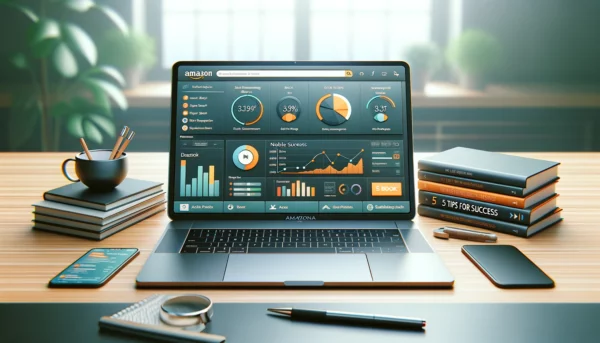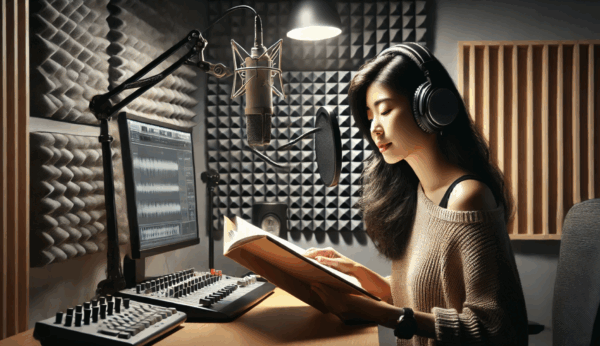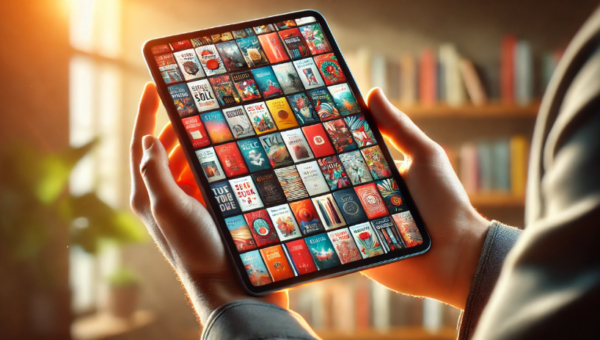Why are my arms getting shorter?”—a humorous lament often heard from those who suddenly find themselves holding books at arm’s length just to read the text. But jokes aside, for millions of partially sighted readers, older adults, and even young readers with dyslexia, standard print can feel like a workout for the eyes.
Creating large print editions isn’t just about adding a little extra ink to the page; it’s about expanding your reach as an author, boosting accessibility for those with visual impairments, and welcoming new readers into your world. In a market where indie authors are constantly looking for ways to stand out, self-publishing large print books is a surprisingly untapped opportunity. Large print finally makes it easier for readers to identify and choose the right edition.
In this guide, we’ll walk you through everything you need to know to create and self-publish a successful large print edition. From selecting the right font size to marketing your book, we’ve got you covered.
Understanding Your Target Audience
Creating a large print edition is all about understanding who will benefit from it. Large print editions are designed for readers who struggle with standard print due to visual impairments or age-related issues. Knowing your target audience is crucial to creating a successful large print edition.
Start by considering the demographics of your target audience. Are they older adults, partially sighted readers, or individuals with dyslexia? Understanding their age, reading habits, and visual abilities will help you tailor your book to meet their needs.
Research is key. Look into the specific needs and preferences of your target audience. What font size do they find most comfortable? How much line spacing do they need? What type of paper reduces glare and enhances readability? Use this information to make informed decisions about your large print edition.
By focusing on the needs of your target audience, you can create a large print edition that is not only accessible but also enjoyable to read.
What is a Large Print Edition? Understanding the Basics
Large print books are not just blown-up versions of regular books; they’re carefully crafted for readability. A typical large print edition features a minimum font size of 16-18 points, wider line spacing, and simpler design elements to accommodate partially sighted readers. Macular degeneration is one condition that benefits significantly from large print editions. But it’s not just about font size—readers with dyslexia, eye strain, or even those who simply prefer a more relaxed reading experience also appreciate these editions.
So, what’s in it for you as an indie author? By publishing large print versions, you can diversify your offerings, potentially increase sales, and stand out in a crowded marketplace. Additionally, creating a larger print version is crucial for reaching specific audiences, such as seniors and the visually impaired.
Benefits of Large Print Editions
Creating a large print edition of your book can open up a world of benefits for both you and your readers. Here’s why you should consider it:
- Increased Accessibility: Large print editions make your book more accessible to readers with visual impairments, such as macular degeneration, cataracts, and other conditions that affect vision. By offering a large print version, you’re ensuring that everyone, regardless of their visual abilities, can enjoy your work.
- Wider Audience: By creating a large print edition, you can reach a broader audience, including seniors, people with reading difficulties, and those who prefer to read in low-light environments. This means your book can find its way into the hands of more readers who might otherwise struggle with standard print.
- Improved Readability: Large print editions can improve readability for all readers, not just those with visual impairments. The larger font size reduces eye strain and makes it easier to focus on the text, providing a more comfortable reading experience.
- Enhanced User Experience: A large print edition can offer a more enjoyable reading experience. Readers can immerse themselves in your story without the distraction of struggling to read the text. This can lead to more positive reviews and word-of-mouth recommendations.
- Increased Sales: Offering a large print edition can boost your sales and revenue. Readers who prefer large print are more likely to purchase your book, and you’ll be tapping into a market that’s often overlooked. It’s a win-win situation for both you and your readers.
By embracing large print editions, you’re not only expanding your reach but also showing your commitment to inclusivity and accessibility.
Choosing the Right Font Size and Type for Large Print Versions
Font Size: The magic number for large print books is 16-18 points. While a standard print book might use 11-12 point font, increasing the size significantly improves readability and reduces eye strain. However, keep in mind that a larger font size means a longer page count, which can influence both the cost of production and the final price of your book. Additionally, consider how many pages your manuscript has, as this can further influence your choice of font size to ensure accessibility for those with visual impairments.
Font Type: Sans serif fonts like Arial, Verdana, and Helvetica are your best friends here. These fonts have clean lines and no extra frills, making them easier on the eyes. Avoid using italics and all-caps text—unless you want your readers to feel like you’re shouting at them in bold! Also, steer clear of fonts that look like they were borrowed from a horror movie poster.
Your Publishing Journey Awaits – Start NowEssential Formatting Tips for Large Print Documents
When formatting your large print book, a few tweaks can make all the difference:
- Line Spacing: Set line spacing to at least 1.5, or even double spacing, to give the text more breathing room. This prevents the page from feeling crowded.
- Text Alignment: Align text to the left (ragged right) instead of fully justified. This prevents awkward gaps that can be confusing for readers.
- Paper Choice: Use cream-colored paper rather than bright white to reduce glare. Cream paper enhances the reading experience by being easier on the eyes, especially under artificial lighting, and contributes to a more visually appealing and comfortable reading environment.
- Paragraphs and White Space: Avoid long, dense paragraphs. Short paragraphs with ample white space help readers navigate through the text more comfortably.
These changes may sound minor, but trust us—they’ll make your book a joy to read, not an endurance test.
Selecting the Perfect Trim Size for Large Print Editions
Choosing a larger trim size like 6×9 inches or 7×10 inches allows you to use bigger fonts while keeping your page count manageable. A larger trim size also enhances the overall look of your book, giving it a more substantial feel. However, be mindful of the fact that a larger book may lead to higher shipping costs. It is important to note that normal print typically requires smaller font sizes compared to large print, but readability should always be maintained, avoiding smaller text for essential information.
Pro tip: If you’re wondering whether your next book should be a “small” large print edition, remember that size does matter—at least when it comes to accessibility!
Crafting a Consistent Layout and Design for Accessibility
Consistency is key to making your large print edition user-friendly. Here are some tips:
- Chapter Headings: Use bold, large-sized fonts for chapter titles to make them easy to locate.
- Block Paragraphs: Avoid indentations; instead, use block paragraphs with spaces between them.
- Page Headers and Numbers: Include clear page headers and numbers, but keep them simple—nothing fancy. This helps partially sighted readers navigate your book easily.
- Single Lines: Avoid leaving single lines (orphans) at the top of a page and ensure you have enough white space.
A clear layout and consistent formatting can make all the difference for readers with visual impairments. Additionally, incorporating visual accessibility features such as large font size can significantly enhance the reading experience for low-vision readers.
Cover Design Considerations for Large Print Editions
While we all love a flashy, intricate book cover, less is more when it comes to large print editions. Here’s why:
- Use large, bold titles that are easy to read from a distance.
- Keep the background simple and high-contrast. Your cover design should not look like it’s trying to win “Where’s Waldo?”
- Stick to clean visuals, avoiding overly detailed images that may be hard to interpret.
Whether it’s a paperback or hardback version, a clean, accessible design will attract readers who are searching for large print options.
ISBN and Copyright Considerations for Large Print Books
When creating a large print edition of your book, it’s essential to consider the ISBN and copyright implications. Here’s what you need to know:
- ISBN: You will need to purchase a separate ISBN for your large print edition, as it is considered a different format from your standard print edition. In the US, you can purchase ISBNs from Bowker, while other countries have their own ISBN agencies. This unique identifier helps distinguish your large print book in the marketplace.
- Copyright: Your large print edition will be protected by the same copyright as your standard print edition. However, it’s a good idea to update your copyright notice to reflect the new format. This ensures that your intellectual property is safeguarded across all versions of your work.
- Formatting: When formatting your large print edition, use a clear and readable font, such as a sans serif font like Arial or Verdana. Adjust the font size to at least 16-18 points and increase line spacing to make the text easy to read. These changes are crucial for creating a reader-friendly large print book.
- Content: The content of your large print edition should be identical to your standard print edition, with the exception of formatting changes to accommodate the larger print size. This ensures consistency across all versions of your book.
- Distribution: You can distribute your large print edition through the same channels as your standard print edition, including online retailers, bookstores, and libraries. Consider expanded distribution options to reach a wider audience, including those who rely on large print books.
By addressing these considerations, you’ll be well on your way to successfully publishing a large print edition that meets the needs of your readers and stands out in the market.
Preparing Your Book for Print-on-Demand
Before you dive into creating a large print edition, it’s essential to ensure your book is formatted correctly for print-on-demand services. This step is crucial for producing a professional-looking large print book.
Start with the font. Use a clear, sans-serif font like Arial or Helvetica, and set the font size to a minimum of 16 points. This makes the text easy to read for those with visual impairments.
Next, choose a trim size that suits large print editions. Sizes like 6×9 inches or larger are ideal as they allow for bigger fonts without making the book too bulky.
Your Publishing Journey Awaits – Start NowPaper choice is also important. Opt for cream paper instead of bright white to reduce glare and improve readability. Cream paper is easier on the eyes, especially under artificial lighting.
Ensure your book has a clear and consistent layout. Use large font sizes for headings and subheadings, and consider using bold or italic text to highlight important information. This helps readers navigate the book more easily.
By paying attention to these details, you’ll create a large print edition that is both accessible and visually appealing.
Formatting Large Print Books for KDP Print and Expanded Distribution
Publishing your large print edition on platforms like Amazon KDP Print is easier than you might think:
- Ensure your book meets KDP’s formatting guidelines for large print books.
- Choose expanded distribution to reach libraries and bookstores that cater to partially sighted readers.
- Consider the cost implications of larger print books. Shipping, printing, and production costs might be higher, so plan your pricing accordingly.
Publishing large print editions can also improve your book’s visibility, helping you connect with a new audience.
Distribution Channels for Large Print Editions
Once your large print edition is ready, it’s time to think about distribution. There are several channels you can use to get your book into the hands of readers who need it.
Online retailers like Amazon KDP and IngramSpark are excellent options for distributing large print editions. These platforms offer print-on-demand services, making it easy to produce and distribute your book without upfront costs. When setting up your book, make sure to select the large print option and use keywords like “large print edition” or “large print book” to help readers find it.
Don’t overlook brick-and-mortar stores and libraries. Consider donating a copy of your large print edition to your local library. This not only increases visibility but also helps you reach a wider audience.
Promoting your large print edition is also crucial. Use social media and online marketing to reach your target audience. Share stories about why you created the large print edition and how it can benefit readers. This personal touch can make a big difference in attracting readers.
By leveraging these distribution channels and marketing strategies, you can ensure your large print edition reaches those who will benefit from it the most.
Marketing Your Large Print Book to Reach New Audiences
Now that your large print book is ready to hit the market, let’s talk strategy:
- Ebook Stores: While large print is usually associated with physical books, don’t ignore the benefits of listing on ebook stores.
- Local Libraries: Reach out to local libraries and organizations that support partially sighted individuals. They are often looking for accessible reading materials.
- Social Media and Blog Posts: Promote your large print edition on your blog and social media channels. Share stories about why you created it and how it can benefit readers.
Word of mouth is powerful—especially if you’ve made a positive impact on someone’s reading experience.
Additional Considerations and Final Tips for Indie Authors
A few more tips to wrap things up:
- Consider having partially sighted beta readers review your book before publishing.
- Test your book’s readability on multiple devices and print versions to ensure everything looks perfect.
- Maintain great customer service by being responsive to feedback and willing to make adjustments.
Remember, the effort you put into creating a large print edition doesn’t just expand your readership—it also shows your commitment to inclusivity.
Self-Publish Large Print Books: Embracing Large Print to Broaden Your Audience
Self-publishing a large print edition is more than just a strategic move to boost sales—it’s about giving more people the joy of reading. By making your books accessible to partially sighted readers and those who simply prefer larger text, you’re opening doors to a world of new possibilities.
As an indie author, embracing this growing market can set you apart. So, what are you waiting for? It’s time to add “large print” to your publishing journey! Are you ready to create your first large print edition? At Spines, we provide the tools and resources you need to publish your next great read. Get started today and reach a whole new audience!
Your Publishing Journey Awaits – Start Now






